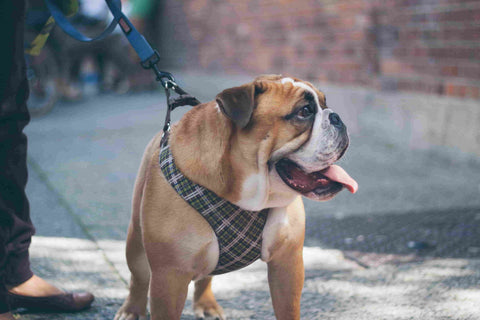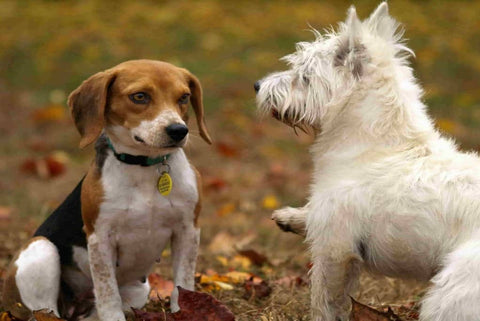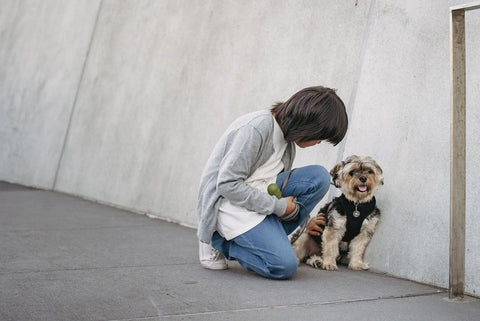What Age Can You Start Using a Dog Harness?
A dog harness is a great tool for safety and training, that’s also versatile. You can use them with dogs of almost any age or size, as long as you choose the right one. The sooner you start your puppy with a harness, the better, actually. They’re a good way to teach dogs how to walk properly without pulling.
Around eight months is usually the time experts say you can start using a harness as part of walking skills and training development, ideally.
What is the Best Harness for Training a Puppy?
The first consideration when you’re choosing the best harness for training a puppy is to make sure you get the right size. We go over how to do that in more detail below. Beyond that, other features to look for when you choose a harness for a puppy are:
- Is it made from soft, comfortable materials? You want your puppy to be as comfortable as possible in their harness, so they’ll enjoy walks and they’ll become an important part of your daily routine. If a harness isn’t made from soft, comfortable materials, then your dog may start to be resistant to walks.
- An adjustable harness is important. Yes, you will measure to make sure you get the properly sized harness, but still, being able to adjust it is going to make the fit even more perfect.
- Since you’re going to be taking your dog out for frequent walks with your new harness, ensure that it’s user-friendly for you as you’re taking it on and off.
- Look for an option with both a front and top leash connection. When you attach your dog’s leash to the D-ring in the front of a harness, it’s good for training. If your dog pulls, then it puts some tension between their shoulders, training them not to do this. Once your dog is ready, you can use the top clip without having to get a new harness.
- If you walk in the early morning or evening, choose a harness that has some reflective elements to improve your safety.
How to Pick the Right Size Harness for Your Puppy?
Don’t choose a harness for your puppy without measuring first. This is critical.
- #1 Get your dog’s measurements. Start by taking your dog’s measurements of their neck girth, which is at the base of their neck. Then, take a measurement of their belly girth. This measurement starts around an inch in front of the back legs.
The final important measurement that you’ll need to choose a harness for a puppy is their body length. Start right behind the front leg, and measure to just behind their back leg.
-
#2 Pick up the right size. Then, when you’re shopping Pet&Cuddle’s harnesses, you’ll see a size chart that will guide you to the right option for a perfect fit for your puppy.
If your dog is closer to the larger end of a measurement listed on a size chart, opt for the bigger size. When you size up, you can still adjust the straps, but it reduces the risk of injury that can come from using a harness that’s too small.
- #3 Adjust a dog harness if needed. When you put your dog’s harness on for the first time, check the size and assess any needed adjustments by putting two fingers under any of the straps. Another way to check that the harness fits securely is to try and pull it over your dog’s head, which you shouldn’t be able to do when it’s fastened and adjusted.
How to Use a Harness Properly
The biggest thing to remember when you’re choosing a harness for a puppy or any dog is to make sure that you’re getting the right fit. One that’s either too big or too small can potentially injure your puppy.
Make sure that a harness isn’t so tight that it’s obstructing your dog’s movement.
The girth strap should be located behind your dog’s elbows while they’re standing and while they’re sitting, that shouldn’t be digging into their elbows. The harness should not go over the shoulders or across the front legs either.
A few other things to keep in mind about how to use a harness the right way include:
- Make sure your dog can fully reach their front leg forward and their front leg to the side when wearing their harness.
- It should not look like it’s hanging from your dog. Again, there should only be two fingers you can fit under the straps of the girth and neck.
- Your dog should always look and seem comfortable when its harness is on.
Tips for Adapting Your Puppy To a Harness
Learning how to use a harness is like learning any other skill for your puppy. They need time to adapt so they aren’t intimidated or afraid. Consider the following tips to help your puppy get used to a new harness:
- The harness should be something you introduce gradually. For example, put it on the ground or hold it and let your dog play with it a bit.
- You can also bring a harness on a walk with you, even if you aren’t yet using it. They’ll see that it’s part of their walk, however, and get used to it.
- Start your dog out by having him wear his harness around the house for short periods of time.
- Finally, when you feel like your dog is ready, you can go on your first walk in the harness, but you should only work up to this step gradually.
Can I Use a Retractable Leash with a Harness for Puppies?
Some people worry that a retractable leash is dangerous when it’s used with a harness. That’s not the case at all, and they have a lot of advantages over a fixed-length leash.
However, there are a few things to note. First, choose a durable, safe, and good quality retractable leash, like the ones we offer at Pet&Cuddle.
Also, when you’re training your dog and you’re using the front clip of your harness, make sure you’re giving the leash a little extra slack. If not, your dog may be walking properly, but because of the tension, may get confused and think he’s pulling.
You can also attach a retractable leash to the top clip of a harness to avoid this tension.
Benefits of Using a Harness for Puppies
When you have a good-fitting harness for your puppy, it makes every activity you do together more enjoyable and safer. That includes playing, training, and walking. The following are some of the key advantages of a harness over a conventional collar for a puppy:
- More Secure. A harness tends to be safer than a collar. It distributes pressure all over your dog’s body, rather than concentrating it only at their neck, reducing the risk of injuries.
- Better Comfort. A harness is comfortable since there’s not a lot of pressure being applied directly at the neck. Your dog can feel freer on their walks without a feeling of suffocation or restriction that can come from a collar.
- Improved Control. A harness will give you more control when you’re walking your dog, especially if he tends to pull a lot or is difficult to control on walks. When you feel more in control, you’ll feel calmer and more confident when you walk, even in busy areas.
We, the Pet&Cuddle dog lovers, have created a unique harness collection for your dogs, which is safe for the dog and can be used for training, leading, or adapting your pet for walking with a leash.
Discover the best dog harnesses we created exactly for your dog here.
Questions About Puppy Harnesses
As the leaders in creating comfortable, safe puppy harnesses, we compiled answers to a few of the most common questions we get.
1. Is It Safe to Put a Harness On a Puppy?
We know as a puppy parent, safety is your top priority. The same is true of our brand. Yes, it is absolutely safe to use a harness for a puppy, as long as you choose one that’s well-made and is the right size for your dog. If it fits well without being too loose or uncomfortable, a harness actually tends to be a safer option than a collar.
2. Can Puppies Wear Harnesses All Day Long?
A harness can be worn for a long walk or playtime, but when that’s over, and you come home, remove the harness. They aren’t made to be worn all day, and they can cause irritation and discomfort for your dog if they are. You want your dog to get into a habit of knowing that when their harness comes out, it’s time to go for a walk.
3. What is a No-Pull Harness?
A no-pull harness is one that reduces your dog’s ability to pull when you’re walking, so you can have the highest level of control. It can be used by any breed and dogs of any size, and they’re great for training and everyday use. They don’t hurt your dog, and they’re much gentler than a choke collar, but they’re an effective training tool for proper walking technique.
4. How Tight Should a Harness Be?
A harness should never be so loose that your dog can slip out of it, and it shouldn’t be loose to the point that it’s getting tangled in your leash. The fit should be snug, but at the same time, never so tight that your dog could get hurt or their movement is restricted.
A good rule is to see if you can put two or perhaps three fingers underneath the harness easily. If so, that’s probably the proper fit. If not, you may need to either get a different size or re-adjust your harness.
Get Your First Dog Harness From Pet&Cuddle
Choosing a comfortable, safe harness for your puppy is a rewarding part of bringing someone new into your family. A harness is something that will give you a lot of use, help you train your puppy, and make walks the high point of your day each day.
We, at Pet&Cuddle, have processed all the knowledge and practical experiences to create the perfect harness with a unique design. Comfortable and safe, it now can be easily used for many purposes like training, walking, or adapting to a leash.
Discover the latest products for dogs available on our website!




